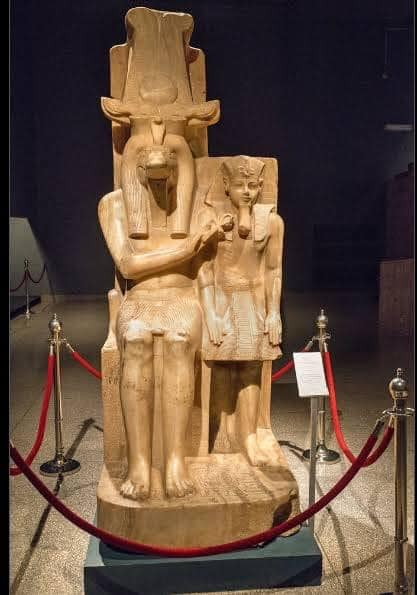Statue of Sobek and Amenhotep III

A masterpiece from the ancient era. This statue that you see is the statue of Sobek and Amenhotep III, and it dates back to the year 1403 - 1365 BC.
This double statue depicts King Amenhotep III and Sobek, the god of Kom Ombo, who is the god of crocodiles and fertility
The statue shows the king and the deity sitting on a chair decorated with hieroglyphic inscriptions bearing the titles of Ramesses II, who restored the statue during his reign.
Such a statue is Amenhotep III with the idol Sobek, the Lord of Faiyum, in the form of a crocodile. The statue is in an almost perfect state of preservation. It was found at the bottom of a well filled with water. It may have been used in ancient Egypt as a residence and as a breeding place for the temple’s sacred reptiles, which are crocodiles. This well was in Inside a temple in the Somno area near Arment. It was locked with a limestone slab that slid on two bronze wheels.

About a century after this statue was sculpted, Ramesses II erased the name of the original owner of the statue from the front of the Sobek throne, and added his personal writings to the base, to the king’s belt, to the right side of the throne, and to the back and sides of the back pillar. But he did not change the face of the pharaoh, although it is easy to recognize Amenhotep III with his distinctive features such as the shape of a sacred uraeus or a royal cobra, and the single incised line above each eye. The king's beautiful face conveys a sense of youth, and it may have been sculpted for the king in the middle of his reign.
We find the king here appearing with influences from Amarna art, as in the royal shindid or the short kilt that appears inflated or protruding from the front, which is the beginning of Amarna art. We also find the idol Sobek extending his hand towards Amenhotep with the sign of life (ankh) as if he was granting him life and immortality.

Material- (Egyptian Alabaster-Bronze)
Height- 256.5 cm
Presentation - Luxor Museum.
It is very clear to those who saw this statue that the attempt was stolen, especially with cartouches. Some letters were erased and others were carved - unfortunately, the scourge of erasing names was one of the most dangerous scourges of ancient Egyptian civilization.
You can visit this statue in the Luxor Museum, and enjoy its beauty and details. Don't miss this unique opportunity to learn about Egypt's great history
Source: websites

